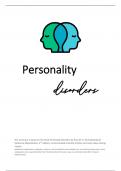Summary
Personality disorders_in-depth summary
- Course
- Institution
- Book
This in-depth, easy-to-read summary contains notes from the book, classes and recommended scientific articles. It also has extra explanations, annotations, tables and pictures to make learning easier and quicker. Good luck!
[Show more]




